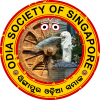Festivals
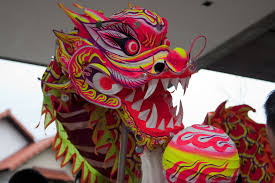 The Chinese
celebrate the Lunar New Year with gusto sometime in January or February, depending
on the Lunar Calendar. This is the equivalent of the American Christmas and Thanksgiving
combined. There is a big reunion dinner on the eve of the New Year. Expatriates
frequently skip town during this period because most shops are closed. Some Chinese
businesses close shop for up to two weeks-the only break they have in the year.Other
Chinese festivals include Qing Ming (a time for the remembrance of ancestors), the
Feast of the Hungry Ghosts, and the Mid-Autumn Festival (also known as the Mooncake
or Lantern Festival).
The Chinese
celebrate the Lunar New Year with gusto sometime in January or February, depending
on the Lunar Calendar. This is the equivalent of the American Christmas and Thanksgiving
combined. There is a big reunion dinner on the eve of the New Year. Expatriates
frequently skip town during this period because most shops are closed. Some Chinese
businesses close shop for up to two weeks-the only break they have in the year.Other
Chinese festivals include Qing Ming (a time for the remembrance of ancestors), the
Feast of the Hungry Ghosts, and the Mid-Autumn Festival (also known as the Mooncake
or Lantern Festival).
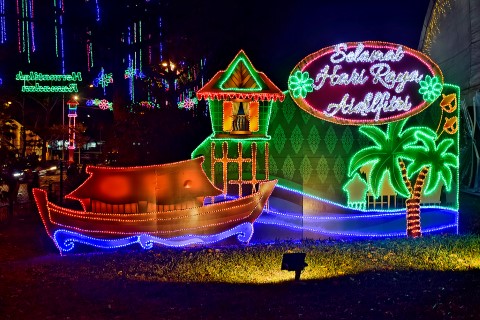 Muslims in Singapore celebrate two main festivals.Hari Raya Puasa is
a joyous celebration to mark the end of a month of fasting. Muslims decked in finery
visit each other. Hari Raya Haji is a time of prayer and remembrance. Smaller-scale
festivals are: the first day of the Muslim calendar month of Muharram (a New Year
celebration), and Maulud (Prophet Muhammad's birthday).
Muslims in Singapore celebrate two main festivals.Hari Raya Puasa is
a joyous celebration to mark the end of a month of fasting. Muslims decked in finery
visit each other. Hari Raya Haji is a time of prayer and remembrance. Smaller-scale
festivals are: the first day of the Muslim calendar month of Muharram (a New Year
celebration), and Maulud (Prophet Muhammad's birthday).
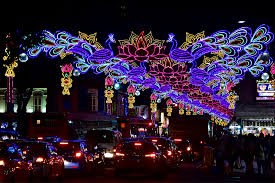 Hindus celebrate
the Tamil New Year sometime in mid-April, while other Indian groups observe New
Year at different times.Thaipusam is a penitential Hindu festival popular with Tamils.
This is the festival where Indians walk several miles carrying kavadis that pierce
their bodies, to thank their gods for answering their prayers. Deepavali, the Festival
of Lights, is celebrated by Hindus and Sikhs. Other festivals include Thimithi (fire-walking
ceremony) and Navarathiri (nine nights' prayer).
Hindus celebrate
the Tamil New Year sometime in mid-April, while other Indian groups observe New
Year at different times.Thaipusam is a penitential Hindu festival popular with Tamils.
This is the festival where Indians walk several miles carrying kavadis that pierce
their bodies, to thank their gods for answering their prayers. Deepavali, the Festival
of Lights, is celebrated by Hindus and Sikhs. Other festivals include Thimithi (fire-walking
ceremony) and Navarathiri (nine nights' prayer).
Christian festivals have a fairly strong following in Singapore. Christmas in particular is heavily commercialised. The entire stretch of the Orchard Road shopping belt is lit up with decorative lights from November to early January.
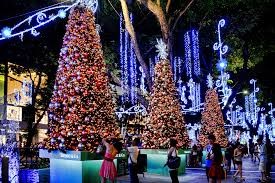 The multiracial mix is such that most Singaporeans celebrate more than
just the festivals of their own ethnic group. So a Chinese Christian might go to
church, but also partake in the cultural rites in some Chinese festivals. Even when
they don't actually celebrate certain festivals, many will visit their friends and
neighbours from other ethnic communities to join in the fun. Of course (Singaporeans
being the foodies that they are) it helps when you have Chinese noodles, Malay "satay"and
Indian curry thrown in.
The multiracial mix is such that most Singaporeans celebrate more than
just the festivals of their own ethnic group. So a Chinese Christian might go to
church, but also partake in the cultural rites in some Chinese festivals. Even when
they don't actually celebrate certain festivals, many will visit their friends and
neighbours from other ethnic communities to join in the fun. Of course (Singaporeans
being the foodies that they are) it helps when you have Chinese noodles, Malay "satay"and
Indian curry thrown in.
Customs and Cultural Taboos
We all have our ways and idiosyncrasies. While most young Singaporeans don't give two hoots, their elderly counterparts are usually more sensitive to cultural dos and dont's. Here are some pointers to note:
| • | Chinese like things in even numbers, for example,two Mandarin oranges as a token during the Lunar New Year visiting |
| • | 2 ("yi"=easy), 6 ("lok"=wealth) and 8 ("patt"=prosper) are considered lucky numbers. 4 ("sei"=death) is deadly |
| • | Taboo gifts are clocks ("zhong"=funeral), handkerchiefs (associated with tearful partings) and umbrellas (associated with mishaps) |
| • | Red is an auspicious colour, as are other bright colours, while black is frowned upon by the older generation, especially during festive occasions |
| • | Muslims don't eat pork. When entertaining Muslim guests, check that no pork, lard or alcohol is used in the cooking, and that the meat is bought from a 'halal' food supplier. Never bring wine when visiting a Muslim home and always dress modestly |
| • | Muslims fast during the Ramadan month, celebrated in the month of Ramadan on the Muslim calendar, the exact date of which moves ahead by 11 days every calendar year. Therefore in this year (2000) Hari Raya Puasa is celebrated |
| • | Hindus don't eat beef. Some are strict vegetarians, as are some Buddhists |
| • | For funerals, attend in somber colours. Small tokens of money are the norm--wrapped in white or brown packets and in odd amounts |
| • | Singaporeans go barefoot inside their homes, so take off shoes at the front door during visits |
When in doubt, ask Singaporean friends or colleagues. Otherwise, let good sense prevail.
